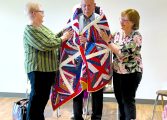“The reason I wrote the book for librarians, teachers, and parents was because it is a valuable tool, giving a brief history of the English alphabet and the history of alphabet books with accompanying web sites,” said Mackey.
The devoted grandmother of five granddaughters spent time doing research in libraries and scouring book stores and thrift shops looking for alphabet books: new, old and antique. Her niece, who has a Bachelor of Arts in art history from the University of Virginia and a Master’s of Business Administration from George Mason University, was successful in finding the artistic alphabet books.
“We broke it down to three categories of text structure found in alphabet books: single letter, hidden letters and conceptual text,” said Mackey, citing examples of all three.
Mackey discussed the alphabet’s history, beginning in 2000 B.C. with origins in the ancient Middle East. The alphabet began with hieroglyphs, or picture symbols, in Egypt. It started out with 18 letters. Phoenicians spread it to their various trading partners, including the Greeks.
Around 200 B.C. the Romans had expanded the Greek alphabet to 23 letters excluding J, U, and W. The 23-letter Latin alphabet extended into Europe and Britain.
By the late 1600s V was used as a consonant and U was a vowel. W was added in the 11th century by Norman scribes and it wasn’t until 400 to 500 years ago that J was added. The alphabet continued to evolve and was tweaked by many language scholars through the late 1800s. The modern alphabet we all know is a result of the evolution of sound and language.
As for the future of the alphabet, Mackey hesitated to speculate, saying, “It’s never wise to predict the future when it comes to language.” Our culture has witnessed changes to the dictionary, keeping pace with current trends and technology, which Mackey said will be the telltale sign of the future of the alphabet. “Will the 26 letters as we know them remain intact as rapidly growing technological advances in the internet, including Twitter and texting, become the mainstays of communication? If any letters are added or deleted, so goes the future of the alphabet books.” Mackey is not adverse to new technology; on the contrary, she texts with the best of us.
The first alphabet books published were the hornbooks in the late 1600s adapted from lesson books printed in Europe in the 1450s. Mackey and Watson held one of these books while visiting the Library of Congress’s rare book and special collection. Mackey’s eyes lit up when she described the feeling of holding alphabet books and other learning materials that were 200 to 300 years old in her white gloved hands. She said it was like holding history.
“A hornbook is a piece of parchment paper or paper pasted to a wooden board and protected by a very thin, see-through sheet of animal horn,” she said. “The Puritans brought them to America and used them to teach their moral and religious beliefs. The alphabet was added in the early 1600s to teach children the letters while instructing in strong morals and values.”
Battledores replaced hornbooks in the mid-1700s. A more complex design, the battledore got its name from its resemblance to the wooden racquet used in the game of battledore – a colonial version of badminton.
“These books reflected the current sociocultural and religious ideas, but they reveal a gradual shift toward more secular topics,” said Mackey.
By 1777 the New England primer was introduced. It was the most successful teaching tool used until the 1800s but some still used it until 1900. It included the alphabet in rhyme form but the focus was religious instruction.
Abecedariuses built on the rhyming aspect of earlier alphabet books and continued through the 19th and 20th centuries. Other related alphabet books included the Shaker Abecedarius and the Acrobatic Alphabets.
“The Acrobatic ones are the alphabets where the human form positions itself in the shapes of the letters,” said Watson. She pointed to an example of a human in the shape of a letter position.
Nowadays alphabet books are interactive, three-dimensional, tactile and electronic, appealing to a different generation as well as being bilingual for those learning another language.
Mackey and Watson have shown the vast cultural differences from when Europeans settled in the U.S. over 300 years ago to today’s students.
In the 1700s J was for judge. Most children have little concept of what a judge is, but making J stand for jam, jump or jet made the association easier. Mackey showed her example for B, a bear with a band aid, buttons, belt, buckle, boots and a bow, thus focusing on multiple items for one letter. The idea is to have children learn about a variety of things rather than zeroing in on one aspect of societal norms.
Mackey is available for presentations on the book as a teaching tool. For more information, contact her at mackey_bonnie@yahoo.com.




